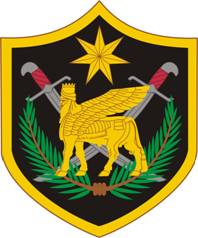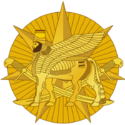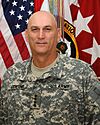Multi-National Force – Iraq facts for kids
Quick facts for kids Multi-National Force – Iraq |
|
|---|---|
| Participant in the Iraq War and the War on Terror | |

Multi-National Force-Iraq Shoulder Sleeve Insignia with the Star of Ishtar and Lamassu symbols
|
|
| Active | 14 May 2004 – 31 December 2009 |
| Leaders | |
| Headquarters | Baghdad, Iraq |
| Preceded by | Combined Joint Task Force 7 |
| Succeeded by | |
| Allies | |
| Opponents | |
| Battles and wars | Global War on Terrorism |
| Distinctive unit insignia |  |
| Flag |  |
| Flag |  |
The Multi-National Force – Iraq (MNF–I) was a military group formed by many countries. It was also called the Coalition forces. This group was in charge of military operations during the 2003 invasion of Iraq and most of the Iraq War. The United States, United Kingdom, Australia, Italy, Spain, and Poland were some of the main countries involved.
The MNF-I took over from an earlier group called Combined Joint Task Force 7 on May 15, 2004. Later, on January 1, 2010, it changed into a new group called United States Forces – Iraq. The MNF-I got a lot more troops during the Iraq War troop surge of 2007. By May 2011, all countries except the U.S. had left Iraq. The U.S. military left on December 18, 2011, which marked the end of the Iraq War.
The United Nations Assistance Mission for Iraq (UNAMI) also worked in Iraq. This group focused on helping people and had guards and observers. UNAMI was separate from MNF-I. The NATO Training Mission – Iraq was also in Iraq from 2004 to 2011. Its job was to train the Iraqi Army and the Iraqi Police.
Contents
What Was the Multi-National Force – Iraq?
News channels in the United States often called the Multi-National Force – Iraq the "U.S.-led coalition." This was because most of the soldiers in MNF-I came from the United States. Many countries that sent troops to Iraq usually kept them inside their military bases. This was due to a lot of violence happening across the country.
How the Multi-National Force – Iraq Started
The main goals of MNF-I were set out in a letter from U.S. Secretary of State Colin Powell to the United Nations. This letter was part of a UN resolution in June 2004.
The goals were to help keep Iraq safe. This included stopping terrorism and protecting Iraq's land. The MNF-I also aimed to help the Iraqi people complete their political changes. This would allow the United Nations and other countries to help rebuild Iraq.
Jordan helped train Iraqi security forces. The United Arab Emirates gave military equipment. By September 2008, over 545,000 Iraqi security forces had been trained.
In November 2006, the United Nations decided to let the multinational force stay in Iraq until the end of 2007. The Iraqi government asked for this because they needed more time to build up their own security forces. In December 2007, the UN extended the mission until December 31, 2008.
In December 2008, the U.S. and Iraqi governments signed an agreement. This agreement was only for American troops. It allowed them to stay in Iraq until 2011. However, it changed some rules. Iraq got control of its airspace again. It also gained control over American contractors and off-duty U.S. soldiers who committed crimes. The U.S. troops were supposed to leave Iraqi cities by July 31, 2009. The whole agreement needed to be approved by Iraqi voters.
Countries That Sent Troops to Iraq
Many countries sent troops to Iraq as part of the Multi-National Force – Iraq. Here is a list of some of them and when their troops left.
Troops Leaving Iraq in 2011
 United Kingdom: The UK sent 46,000 troops during the invasion. About 8,500 stayed in southern Iraq. They gradually reduced their numbers. All remaining British troops left Iraq on May 22, 2011. The UK lost 179 soldiers in Iraq.
United Kingdom: The UK sent 46,000 troops during the invasion. About 8,500 stayed in southern Iraq. They gradually reduced their numbers. All remaining British troops left Iraq on May 22, 2011. The UK lost 179 soldiers in Iraq. United States: The U.S. had a large number of troops in Iraq. They helped Iraqi forces with things like air support and training. On January 1, 2010, the main U.S. commands in Iraq were combined into U.S. Forces – Iraq (USF–I). All U.S. combat operations stopped in August 2010. By December 31, 2011, all U.S. troops had left Iraq. The U.S. lost 4,485 soldiers in Iraq.
United States: The U.S. had a large number of troops in Iraq. They helped Iraqi forces with things like air support and training. On January 1, 2010, the main U.S. commands in Iraq were combined into U.S. Forces – Iraq (USF–I). All U.S. combat operations stopped in August 2010. By December 31, 2011, all U.S. troops had left Iraq. The U.S. lost 4,485 soldiers in Iraq.
Troops Leaving Iraq in 2009
 Australia: Australia sent 2,000 people for the 2003 invasion. Their main force was the Overwatch Battle Group (West). This group stopped its operations on June 2, 2008. The Australian military presence in Iraq ended on July 28, 2009. Two Australian soldiers died during the mission.
Australia: Australia sent 2,000 people for the 2003 invasion. Their main force was the Overwatch Battle Group (West). This group stopped its operations on June 2, 2008. The Australian military presence in Iraq ended on July 28, 2009. Two Australian soldiers died during the mission. El Salvador: Salvadoran troops helped guard convoys. The last Salvadoran troops left Iraq on January 22, 2009. El Salvador lost five soldiers in Iraq.
El Salvador: Salvadoran troops helped guard convoys. The last Salvadoran troops left Iraq on January 22, 2009. El Salvador lost five soldiers in Iraq. Estonia: Estonia had units of up to 40 soldiers in Iraq since June 2003. Their mission officially ended on February 7, 2009. Two Estonian soldiers were killed.
Estonia: Estonia had units of up to 40 soldiers in Iraq since June 2003. Their mission officially ended on February 7, 2009. Two Estonian soldiers were killed. Romania: Romania had 730 soldiers in Iraq at its peak. They did many jobs, like questioning prisoners and training. Romania reduced its troops over time. The last Romanian soldiers left Iraq on July 23, 2009. Three Romanian soldiers were killed.
Romania: Romania had 730 soldiers in Iraq at its peak. They did many jobs, like questioning prisoners and training. Romania reduced its troops over time. The last Romanian soldiers left Iraq on July 23, 2009. Three Romanian soldiers were killed.
Troops Leaving Iraq in 2008
 Albania: Albania was one of the first countries to send troops, with 70 in April 2003. They increased their troops to 240 in September 2008. All 240 Albanian troops left on December 17, 2008.
Albania: Albania was one of the first countries to send troops, with 70 in April 2003. They increased their troops to 240 in September 2008. All 240 Albanian troops left on December 17, 2008. Armenia: Armenia sent 46 people for logistics and medical help. They ended their military presence in Iraq in October 2008.
Armenia: Armenia sent 46 people for logistics and medical help. They ended their military presence in Iraq in October 2008. Azerbaijan: Azerbaijan sent up to 250 troops. They provided security for a U.S. Marine camp. Their operations ended on December 4, 2008.
Azerbaijan: Azerbaijan sent up to 250 troops. They provided security for a U.S. Marine camp. Their operations ended on December 4, 2008. Bosnia and Herzegovina: Bosnia and Herzegovina sent 85 soldiers, including a unit for disposing of bombs. Their farewell ceremony was on November 29, 2008.
Bosnia and Herzegovina: Bosnia and Herzegovina sent 85 soldiers, including a unit for disposing of bombs. Their farewell ceremony was on November 29, 2008. Bulgaria: Bulgaria withdrew its main group of 485 soldiers in 2005. Their last 155 troops returned home on December 17, 2008. 13 Bulgarian soldiers were killed.
Bulgaria: Bulgaria withdrew its main group of 485 soldiers in 2005. Their last 155 troops returned home on December 17, 2008. 13 Bulgarian soldiers were killed. Czech Republic: The Czech Republic had 300 troops at first, running a hospital. They gradually withdrew their soldiers. Their mission ended on December 4, 2008. One Czech soldier died.
Czech Republic: The Czech Republic had 300 troops at first, running a hospital. They gradually withdrew their soldiers. Their mission ended on December 4, 2008. One Czech soldier died. Georgia: Georgia sent 300 special forces troops. They increased their numbers to 2,000. Following a war with Russia in August 2008, Georgia pulled all its troops from Iraq. Five Georgian soldiers died.
Georgia: Georgia sent 300 special forces troops. They increased their numbers to 2,000. Following a war with Russia in August 2008, Georgia pulled all its troops from Iraq. Five Georgian soldiers died. Kazakhstan: Kazakhstan sent 29 experts to dispose of bombs. They left Iraq on October 21, 2008. One soldier was killed.
Kazakhstan: Kazakhstan sent 29 experts to dispose of bombs. They left Iraq on October 21, 2008. One soldier was killed. South Korea: South Korea had a large contingent. Their last troops left Iraq on December 5, 2008. One South Korean soldier died.
South Korea: South Korea had a large contingent. Their last troops left Iraq on December 5, 2008. One South Korean soldier died. Latvia: Latvian troops were stationed in different areas. All but three officers left by June 2007. The last three Latvian soldiers finished their mission on November 8, 2008. Three Latvian soldiers were killed.
Latvia: Latvian troops were stationed in different areas. All but three officers left by June 2007. The last three Latvian soldiers finished their mission on November 8, 2008. Three Latvian soldiers were killed. Lithuania: Lithuania sent 120 troops. The remaining 33 members of their group arrived home on August 1, 2008.
Lithuania: Lithuania sent 120 troops. The remaining 33 members of their group arrived home on August 1, 2008. North Macedonia: North Macedonia sent 77 soldiers. Their troops left in December 2008.
North Macedonia: North Macedonia sent 77 soldiers. Their troops left in December 2008. Moldova: Moldova withdrew its 20-member unit before the end of 2008.
Moldova: Moldova withdrew its 20-member unit before the end of 2008. Mongolia: Mongolian troops, who numbered 180, guarded a Polish base. All 100 remaining troops left on September 25, 2008.
Mongolia: Mongolian troops, who numbered 180, guarded a Polish base. All 100 remaining troops left on September 25, 2008. Poland: Poland sent 2,500 troops to southern Iraq. They reduced their numbers over time. These soldiers left in October 2008. Twenty-two Polish soldiers were killed.
Poland: Poland sent 2,500 troops to southern Iraq. They reduced their numbers over time. These soldiers left in October 2008. Twenty-two Polish soldiers were killed. Singapore: Singapore sent ships and aircraft but no ground troops. Their withdrawal was completed on December 23, 2008.
Singapore: Singapore sent ships and aircraft but no ground troops. Their withdrawal was completed on December 23, 2008. Tonga: Tongan Royal Marines guarded a command headquarters in Baghdad. Their mission ended on December 5, 2008.
Tonga: Tongan Royal Marines guarded a command headquarters in Baghdad. Their mission ended on December 5, 2008. Ukraine: Ukraine sent 1,650 troops. Their deployment was reduced over time. The remaining 44 troops left on December 22, 2005. Ukraine suffered 18 deaths.
Ukraine: Ukraine sent 1,650 troops. Their deployment was reduced over time. The remaining 44 troops left on December 22, 2005. Ukraine suffered 18 deaths.
Troops Leaving Iraq in 2007
 Denmark: Denmark's main group of 55 air force members left by December 21, 2007. The main combat troops had left by August 2007. Denmark lost seven soldiers in Iraq.
Denmark: Denmark's main group of 55 air force members left by December 21, 2007. The main combat troops had left by August 2007. Denmark lost seven soldiers in Iraq. Slovakia: Slovakia had 110 troops, mainly destroying bombs. Most were transferred to Kuwait in January 2007. The last two returned by the end of the year. Four Slovak soldiers were killed.
Slovakia: Slovakia had 110 troops, mainly destroying bombs. Most were transferred to Kuwait in January 2007. The last two returned by the end of the year. Four Slovak soldiers were killed.
Troops Leaving Iraq in 2006
 Italy: Italy's group had about 3,200 troops. They gradually withdrew their soldiers. Italian forces handed over control of Dhi Qar province on September 21, 2006, ending their mission. The Military of Italy lost 33 soldiers.
Italy: Italy's group had about 3,200 troops. They gradually withdrew their soldiers. Italian forces handed over control of Dhi Qar province on September 21, 2006, ending their mission. The Military of Italy lost 33 soldiers. Japan: Japan sent 600 soldiers for humanitarian work and rebuilding. They were not involved in combat. All Japanese soldiers left Iraq in July 2006. No Japanese military personnel were killed.
Japan: Japan sent 600 soldiers for humanitarian work and rebuilding. They were not involved in combat. All Japanese soldiers left Iraq in July 2006. No Japanese military personnel were killed. Norway: Norway withdrew most of its 150 troops (engineers and mine clearers) on June 30, 2004. The remaining ten staff officers left by August 2006.
Norway: Norway withdrew most of its 150 troops (engineers and mine clearers) on June 30, 2004. The remaining ten staff officers left by August 2006.
Troops Leaving Iraq in 2005
 Netherlands: The Netherlands sent 1,345 troops. They pulled their troops out of Iraq in March 2005. The Netherlands lost two soldiers.
Netherlands: The Netherlands sent 1,345 troops. They pulled their troops out of Iraq in March 2005. The Netherlands lost two soldiers. Portugal: Portugal had 128 military police. These troops were withdrawn on February 10, 2005.
Portugal: Portugal had 128 military police. These troops were withdrawn on February 10, 2005.
Troops Leaving Iraq in 2004
 Dominican Republic: 302 troops were withdrawn by the end of May 2004. They faced constant attacks but had no deaths.
Dominican Republic: 302 troops were withdrawn by the end of May 2004. They faced constant attacks but had no deaths. Honduras: 368 troops were withdrawn by the end of May 2004. They were sent for rebuilding, not combat.
Honduras: 368 troops were withdrawn by the end of May 2004. They were sent for rebuilding, not combat. Hungary: Hungary's 300 transportation troops left Iraq by the end of December 2004. One Hungarian soldier was killed.
Hungary: Hungary's 300 transportation troops left Iraq by the end of December 2004. One Hungarian soldier was killed. Iceland: Iceland had two Explosive Ordnance Disposal Soldiers before they left.
Iceland: Iceland had two Explosive Ordnance Disposal Soldiers before they left. New Zealand: Two groups of 61 military engineers worked in Iraq from September 2003 to September 2004. They helped with humanitarian work and rebuilding.
New Zealand: Two groups of 61 military engineers worked in Iraq from September 2003 to September 2004. They helped with humanitarian work and rebuilding. Nicaragua: 230 troops left in February 2004 due to financial reasons.
Nicaragua: 230 troops left in February 2004 due to financial reasons. Philippines: 51 medics and engineers were withdrawn on July 14, 2004, after a truck driver was kidnapped. Three Filipino soldiers were wounded.
Philippines: 51 medics and engineers were withdrawn on July 14, 2004, after a truck driver was kidnapped. Three Filipino soldiers were wounded. Spain: Spain had 1,300 troops. The newly elected Prime Minister decided to withdraw them. The last 260 troops left on April 28, 2004. Spain lost 11 military personnel.
Spain: Spain had 1,300 troops. The newly elected Prime Minister decided to withdraw them. The last 260 troops left on April 28, 2004. Spain lost 11 military personnel. Thailand: The last 100 troops from Thailand's 423-person humanitarian group left on September 10, 2004. Thailand lost two soldiers.
Thailand: The last 100 troops from Thailand's 423-person humanitarian group left on September 10, 2004. Thailand lost two soldiers.
Leaders of the Multi-National Force – Iraq
Here are the main commanders who led the Multi-National Force – Iraq:
| No. | Commander | Term | Service branch | Ref. | |||
|---|---|---|---|---|---|---|---|
| Portrait | Name | Took office | Left office | Duration | |||
| 1 | Lieutenant General Ricardo Sanchez (born 1953) |
June 14, 2003 | July 1, 2004 | 1 year, 17 days |  U.S. Army |
||
| 2 | General George W. Casey Jr. (born 1948) |
July 1, 2004 | February 10, 2007 | 2 years, 224 days |  U.S. Army |
||
| 3 | General David Petraeus (born 1952) |
February 10, 2007 | September 16, 2008 | 1 year, 219 days |  U.S. Army |
||
| 4 | General Raymond T. Odierno (1954–2021) |
September 16, 2008 | January 1, 2010 | 1 year, 107 days |  U.S. Army |
||
Deaths of Coalition Troops
When U.S. forces left Iraq in December 2011, a total of 4,804 military personnel from the coalition had died. This table shows the number of deaths for each country.
| Country | Deaths | Reference(s) |
|---|---|---|
| 4,486 | ||
| 179 | ||
| 33 | ||
| 23 | ||
| 18 | ||
| 13 | ||
| 11 | ||
| 7 | ||
| 5 | ||
| 5 | ||
| 4 | ||
| 3 | ||
| 3 | ||
| 2 | ||
| 2 | ||
| 2 | ||
| 2 | ||
| 1 | ||
| 1 | ||
| 1 | ||
| 1 | ||
| 1 |
Images for kids
-
Henadii Lachkov, commander of the Ukrainian contingent in Iraq, kisses his country's flag







